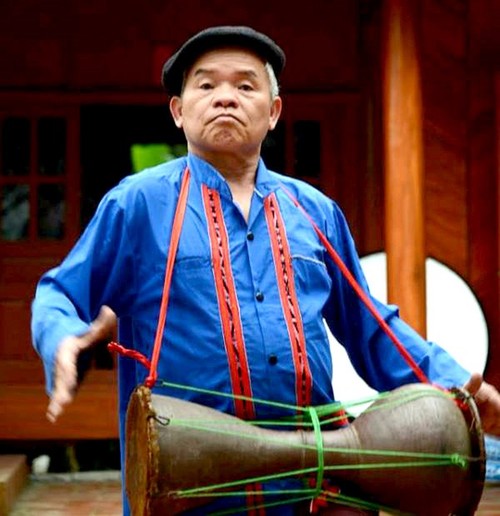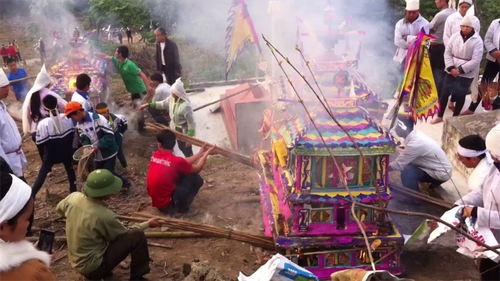When mentioning the Cao Lan people, one will immediately think of their rustic Sinh songs, with simple and warm lyrics sang with great compassion. Those lyrics are even more unique when accompanied by the musical instruments of the Cao Lan people, which are crucial for Sinh songs and for the cultural and spiritual activities of the Cao Lan.
Pí lè pipe, tube drum, and especially clay drum, are among the most unique musical instruments of the Cao Lan people. The drum looks simple, but it is not easy to make. Unlike ordinary drums with bodies made of wood, Cao Lan’s drum body is made from terracotta. It is usually about 40 cm in length, 25 cm in diameter, 16 cm for small drum faces, 5 - 8 mm thick on the drum shell with two cylindrical drum ends and a waist in the middle. Connecting between the two ends of the cavity through the waist in the middle is a hole about the size of a chicken egg. When hitting the large and small drum faces, the sound runs through the waist hole to create different sounds.
The drum faces are made from animal skin. A Cao Lan clay drum face is not made of buffalo skin, but python skin or, the best option, is still varan. Around the face of the drum are iron hooks tied with a small rope across the drum body to keep the two sides clad in the ceramic drum with suitable tension. The excess rope is traversed horizontally and wrapped around the mid-tie section to create extra tension for the two drums.
 A man plays the clay drum (Photo: https://dantocmiennui.vn) A man plays the clay drum (Photo: https://dantocmiennui.vn) |
There are 2 ways to beat the clay drum. If used in rituals, people sit with the drum on their ankles to play. When beating the drum for dancing, Cao Lan people use a cloth to hang the drum around their neck so it sits at their abdomen. The big drum face is beaten directly with 4 fingers, and the small side is beaten by a slightly curved cork stick. Before going to a performance, people often soak the drums in water for 1-2 days to enhance the stretching of the face in order to create a more resonant and soulful sound. A properly made clay drum surface can be used for 20 years before it must be replaced.
People's artist Sam Van Dun in Dai Phu commune, said, "this drum is not used for singing, but mainly to create rhythm for dancing. When beating, the drummer must keep the pace and slap the drum faces in a decisive way. A good drummer can play the drum for an hour long."
The clay drum is an important musical instrument for performing rituals of worshiping the gods, praying for rain, praying for seasons, and praying for good luck. It is also widely used at the Cao Lan ethnic dances during festivals. The drum’s unique design and sound have made the Cao Lan clay drum indispensable in the lives of the people.
In addition to Sinh singing, the Cao Lan people are also famous for their dances, such as the “Múa chim gâu”, the dance expressing the love between couples, or “múa xúc tép”, also known as “Múa sọoc cộng”, the dance that expresses Cao Lan people’s joyful and exciting fishing activities. Along with that, there are cultural and religious activities such as praying for rain, bumper crops, and good luck.
In all the activities, the clay drums are an important element. Mr. Sam Van Dao said, “the clay drums are used in dancing and singing activities of the Cao Lan people, especially at funerals. All of our big houses, like the Lys, Trans, Sams, and Duongs, use clay drums in their major ceremonies. The drums have great spiritual value.”
According to the conception of the Cao Lan people, because of its universality in everyday life, the clay drum is not just a musical instrument, but above all, a sacred symbol closely associated with religion. That is why every time you hear the sound of the clay drum, it is a message to all the people about an important event that will take place. According to Mr. Dao, if someone strikes the drum with no important issues, the Gods will not be happy. It would also annoy neighbors because they will think the family has important work.
The clay drum has long been thought to bear the power of a spiritual creature by the Cao Lan people and shows its holiness in community activities. Because of the inherent sacredness of the drum, it is not easy to select a drummer.
“The drummer is carefully selected. Clay drums are sacred objects, so the people who beat the drums must be knowledgeable and respected by the villagers. A drummer will control the whole dance,” said artisan Sam Van Dao.
Clay drums are more commonly used in religious ceremonies. Therefore, the priest often has his own clay drum to perform rituals at home and in the community.
Mr. Hoang Van Oanh said, “the Cao Lan people only use clay drums in formal ceremonies such as funerals. In the ceremony of burying the dead, they only use small drums, shouting bars and bells.”
 A ceremony to bury the deceased of the Cao Lan ethnic people (Photo: VOV4) A ceremony to bury the deceased of the Cao Lan ethnic people (Photo: VOV4) |
For each priest, a clay drum is a must-have item because during their practice, they will have their own exercises for their followers. However, this practice only takes place during a certain time of the year. The Clay drum is used in the priest’s house. Each year, he will use the drum while teaching his followers how to perform rituals. The teaching period is long, but the priest only uses his clay drum from 25th of the last lunar month to the next full moon.
In the past, clay drums were mainly used by priests, according to artisan Sam Van Dao, but nowadays, anyone can be allowed to play the drum.
In Dai Phu commune, there are now only 2 clay drums. Special attention has been paid to preserve the uniqueness of Cao Lan culture. Mr. Sam Van Dao said clay drums are precious for locals. "On a normal day, the skin of the drum face is removed and hung in the kitchen. When using the drum, people will reattach the skin. We do not leave it always on the drum for fear of a contamination or damage from wild animals," he said.
Statistics of the Tuyen Quang provincial Department of Culture show that there are no more than 10 clay drums in the province. The number of clay drum makers is also modest, making it hard to assemble new drums with the right technique. Every year, cultural centers in Tuyen Quang province invite Cao Lan artists, actors, and priests to perform, exchange, and promote Cao Lan culture and clay drum, the most important musical instrument to their people.
This week, we’ve been talking about clay drums, one of the most unique and important musical instrument of the Cao Lan ethnic people in Tuyen Quang province. We welcome your feedback at: English section, VOVworld, Radio Voice of Vietnam, 45 Ba Trieu Street, Hanoi, Vietnam. Or you can email us at: englishsection@vov.vn. Tune in to our English program on the Internet at vovworld.vn. Good bye. See you next time.